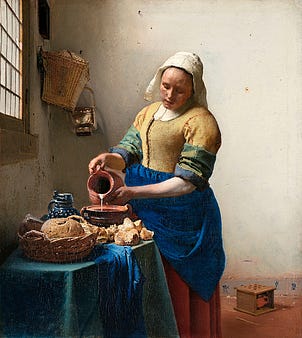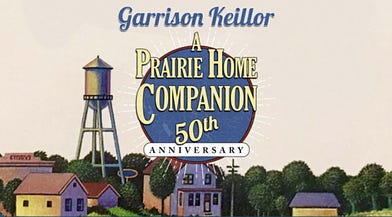|
 |
The Writer's Almanac from Tuesday, October 31, 2017
“Repression” by C.K. Williams from Collected Poems. © Farrar, Straus and Giroux, 2006.
ORIGINAL TEXT AND AUDIO - 2017
Today is Halloween, or All Hallows’ Eve, a day in which the dead are traditionally believed to walk among the living. Communities all across the country throw Halloween parties and parades, but Salem, Massachusetts, goes all out. It started with “Haunted Happenings” in the 1980s, a celebration that took place over a single weekend. But more and more happenings were added to the events calendar every year, until they filled the entire month of October, and now a quarter of a million tourists flock to Salem to celebrate the monthlong Festival of the Dead. There’s a psychic fair and witchcraft expo every day. Psychic mediums deliver messages from departed loved ones — or an expert can teach you how to communicate with the dead on your own. Witch doctors and hoodoo practitioners explain the art of graveyard conjuring. There are séances and cemetery tours. You can solemnly honor your lost loved ones at the Dumb Supper, a feast with the dead. And the whole thing culminates with The Official Salem Witches’ Halloween Ball at the historic Hawthorne Hotel.
Salem has had a complicated relationship with witches ever since the infamous witch trials of 1692. Over the course of a year, nearly 200 residents of Essex County were falsely accused of witchcraft; 19 people were hanged and one man was tortured to death. For generations after the trials, the residents of Salem Town and Salem Village just wanted to put the tragedy behind them — so much so that Salem Village changed its name to Danvers. But some modern-day pagans and Wicca practitioners have turned Salem into a pilgrimage site, so the city ironically, and somewhat uneasily, has made witchcraft part of its marketing strategy. Author J.W. Ocker wrote about this phenomenon in A Season with the Witch: The Magic and Mayhem of Halloween in Salem, Massachusetts (2016). He says: “The Witches, capital W, religious Witches, they balk a little bit at the Halloween witch, because it’s ugly and it’s a stereotype, and it has all these historical associations with it. Then there are people like the historians who balk at the religious witches, who kind of co-opt the cause of the accused witches by saying that they were almost martyrs for the cause. Then there’s the city trying to make everyone happy.”
October 31, 1918 marked the end of the deadliest month in United States history: 195,000 Americans died in one month as a result of the Spanish influenza pandemic. By the time the pandemic had run its course, an estimated 500,000 Americans had died of the flu—and worldwide, the flu may have claimed as many as 100 million lives.
The first known case in the United States was reported on March 11, when a mess cook in Fort Riley, Kansas, reported to the infirmary complaining of fever, headache, and a sore throat. Despite its name, the flu did not originate in Spain. It came to be called the “Spanish flu” because Spain seemed at the time to be particularly hard hit by the virus. The reality was that the Spanish media were actually reporting the outbreak accurately, unlike the media in other countries — namely the United States, the United Kingdom, France, and Germany — which were censoring their newspapers in an attempt to keep morale up during the war.
One Illinois newspaper reported, on this Halloween in 1918: “The ghost parties, masquerades and dances which have always been so popular at this time of the year, are as scarce as the corn and eggs, not because of Mr. Hoover, but because of Mr. Influenza. Many parties which have been planned for Friday and Saturday night have been postponed as the quarantine will not be lifted before next Monday. But not all of the Halloween spirit has been killed by the influenza. Crowds of boys and girls have been using ticktacks on the windows, tearing down gates and beating the porches with planks, for the last three nights, and they are all prepared to be out tonight, so be not surprised if you hear mysterious noise tonight.”
It’s the birthday of English poet John Keats, born in London in 1795. He’s best known for poetic odes like Ode to a Nightingale and Ode on a Grecian Urn, about the famous Elgin marbles on display in the British Museum, which ends with some of the most famous lines in poetic history: “beauty is truth, truth beauty,’ — that is all / Ye know on earth, and all ye need to know.”
By the time he died at the age of 25, John Keats had only published three small volumes of poetry, 54 poems in all. He’s now considered one of the finest poets in the English language. He once told a friend, “I carry all matters to an extreme.”
Today is the birthday of filmmaker Peter Jackson, born in Pukerua Bay, New Zealand (1961). He’s best known for his Oscar-winning adaptation of The Lord of the Rings, but he was first inspired to go into filmmaking by the 1933 monster classic King Kong, which he saw when he was nine years old. “I think I still have a rotting puppet of King Kong somewhere in my basement,” he said. “It was about a foot high. Then I made a cardboard cutout of the Empire State Building for him to stand on, and I painted a backdrop of Manhattan.” He used his parents’ Super-8 movie camera to make home movies featuring his toys and models, with neighborhood kids in acting roles.
Jackson dropped out of high school when he was 16 and went to work full-time to finance his filmmaking passion. He bought a professional-grade camera and recruited his friends to act in a comedy about flesh-eating aliens, which he worked on on his days off. Grants from the New Zealand Film Commission enabled him to quit work and finish the film, now called Bad Taste, which debuted at the Cannes Film Festival in 1988.
His overwhelming success with The Lord of the Rings — a story Jackson first read and loved when he was a teenager — paved the way for him to realize his childhood dream: a remake of King Kong. “I didn’t really give an intellectual thought about what I should change around; it was more emotional,” he said, when he was asked what he changed in his version. “I really was a huge Kong fan, to be simple about it. If somebody else made a remake of King Kong today, I’d be first in line in the cinema with my bag of popcorn in the front row […] because it’s my favorite movie and I’d love to see what they could do today […] But at the end of the day, for me, it’s very selfish because all that I’m ultimately trying to achieve is to make the movie that I want to go see. And that’s what this film is.” Jackson’s version was released in 2005.
The Dutch artist Johannes Vermeer, sometimes known as “Jan,” was baptized in Delft on this date in 1632. Not much is known about the first 20 years of Vermeer’s life. His father, Reynier, was an art dealer, and he also ran a tavern. Reynier died in 1652, and Jan inherited both of these businesses. The following year, he married Catharina Bolnes. He also registered as a “master painter” with the Guild of Saint Luke.
Not much is known about when, why, or how he became an artist. He began his career by painting large-scale biblical scenes, but he’s beloved for his small, intimate glimpses into the daily life of a 17th-century Dutch household.
France invaded the Dutch Republic in 1672, and the Dutch economy crashed. Vermeer died in 1675, at the age of 43, possibly from heart attack or stroke as a result of the stress of his mounting debts. His widow later wrote: “As a result and owing to the very great burden of his children, having no means of his own, he had lapsed into such decay and decadence, which he had so taken to heart that, as if he had fallen into a frenzy, in a day or day and a half he had gone from being healthy to being dead.” There was one painting that meant a great deal to Vermeer; he refused to sell it even to pay his creditors, and Catharina went to great lengths to try to keep it in the family after he died. That was The Art of Painting (c. 1668). It depicts an artist at work in his studio, painting a young woman who is posing as Clio, the Muse of History.
Vermeer wasn’t famous during his lifetime. He didn’t produce many paintings to begin with — only about three dozen survive — and most of them were sold to local collectors. Some of his work was credited to other artists, like de Hooch. It wasn’t until 200 years after his death that his reputation spread outside the Netherlands.
Be well, do good work, and keep in touch.®
Join us for our 50th Anniversary of A Prairie Home Companion! CLICK HERE for a complete listing of our tour and other Garrison Keillor appearances!
If you are a paid subscriber to The Writer's Almanac with Garrison Keillor, thank you! Your financial support is used to maintain these newsletters, websites, and archive. If you’re not yet a paid subscriber and would like to become one, support can be made through our garrisonkeillor.com store, by check to Prairie Home Productions, P.O. Box 2090, Minneapolis, MN 55402, or by clicking the SUBSCRIBE button. This financial support is not tax deductible.


